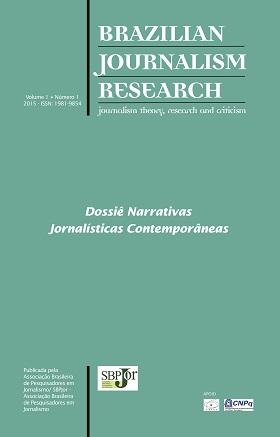Resumo
Este trabalho se concentra sobre a evolução recente o direito e a capacidade dos jornalistas de proteger o anonimato de suas fontes no Reino Unido, particularmente à luz das revelações de Snowden em junho de 2013, bem como a importância da cooperação entre a organização de mídia online WikiLeaks e as organiza ções noticiosas. O artigo explora duas dificuldades principais enfrentadas por jornalistas: a noção de um privilégio profissional qualificado e a extensão desconhecida de solicitações de acobertamento de divulgação por autoridades públicas envolvendo comunicações dados e metadados. Ao fazê-lo, o estudo comenta o caso Wikileaks, que protege suas fontes anônimas por meio da alta segurança de dados e criptografia. Os resultados tendem a mostrar que a prática de cobertura de vigilância digital de massa de comunicações individuais, incluindo jornalistas, está a minar a proteção da fonte e a ascensão do Wikileaks como um modelo alternativo está desafiando o papel tradicional de jornalistas como mediadores e gatekeepers na era digital.Referências
ASSANGE, J et al. Cypherpunks: Freedom and the Future of the Internet. New York, London: OR Books, 2012.
BANISAR, D. Silencing Sources: An International Survey of Protections and Threats to Journalists’ Sources. London: Privacy International, 2007. Available at: https://wikileaks.org/w/images/c/c0/Silencingsources.pdf (accessed August 2014).
BECKETT, C. Wikileaks: Lessons for Media Policy and Regulation. In: LSE Polis 5 March 2012. Available at: http://blogs.lse.ac.uk/polis/2012/03/05/wikileaks-lessons-for-press-policy-regulation/ (accessed October 2014).
BECKETT, C; BALL, J. Wikileaks. News in the Networked Era. Cambridge: Polity Press, 2012.
Big Brother Watch and Others v the United Kingdom App. N° 58170/13 ECHR. Available at: http://hudoc.echr.coe.int/sites/eng/pages/search.aspx?i=001 140713#{%22itemid%22:[%22001-140713%22]} (accessed August 2014).
British Steel Corporation Respondents v Granada Television Ltd. Appellants [1980] 3 WLR 774,[1981] AC 1096.
Bureau of Investigative Journalism. A Summary of the Bureau’s Application to the European Court of Human Rights. London: Bureau of Investigative Journalism, 2014. Available at: http://www.thebureauinvestigates.com/2014/09/14/a-summary-of-the-bureaus-application-to-the-european-court-of-human-rights/ (accessed September 2014).
BURNS, J; SOMAIYA, R. Wikileaks Founder on the Run, Trailed by Notoriety. The New York Times 23 October 2010. Available at: http://www.nytimes.com/2010/10/24/world/24assange.html?pagewanted=all&_r=0 (accessed October 2014).
CANTER, L. Collaboration. In: Zion L and Craig D (eds) Ethics for Digital Journalists. New York and London: Routledge, 2014, pp. 145-158.
Chartered Institute of Journalists. CIoJ Code of Conduct, 2014. Available at: http://cioj.co.uk/the-cioj-code-of-conduct-for-our-members/ (accessed August 2014).
Contempt of Court Act 1981. London: Her Majesty’s Stationery Office. Available at: http://www.legislation.gov.uk/ukpga/1981/49 (accessed August 2014).
CRAVEN, N. How Police Hacked Mail on Sunday Phone. Mail Online 4 October 2014. Available at: http://www.dailymail.co.uk/news/article-2780809/How-police-hacked
-Mail-Sunday-Officers-used-anti-terror-laws-seize-phone-records-identify-source
-exposed-Chris-Huhne-s-speeding-points-fraud.html (accessed October 2014).
Data Retention and Investigatory Powers Act 2014. London: The Stationery Office. Available at: http://www.legislation.gov.uk/ukpga/2014/27/contents/enacted (accessed October 2014).
DAVIES, N. Flat Earth News. London: Vintage, 2009.
Department for Culture Media and Sport; JAVID, S. Final Royal Charter on Self-Regulation of the Press. 30 October, 2013. Available at: https://www.gov.uk/government/publications/leveson-report-cross-party-royal-charter (accessed August 2014).
Digital Rights Ireland Ltd (C-293/12) v Minister for Communications Marine and Natural
Resources and Others and Kärntner Landesregierung (C-594/12) and others. Available at: http://curia.europa.eu/juris/document/document.jsf?doclang=EN&text=&pageIndex=0&part=1&mode=DOC&docid=150642&occ=first&dir=&cid=179393 (accessed October 2014).
DODD, M; HANNA, M. McNae’s Essential Law for Journalists. Oxford: Oxford University Press, 2014.
ELLISON, S. The Man Who Spilled the Secrets. Vanity Fair February 2011. Available at:
http://www.vanityfair.com/politics/features/2011/02/the-guardian-201102.print (accessed October 2014).
FENWICK, H; PHILLIPSON, G. Media Freedom Under the Human Rights Act. Oxford:
Oxford University Press, 2006.
FRANKLIN, B; CARLSON, M (eds). Journalists Sources and Credibility. New York and
London: Routledge, 2013.
Independent Press Standards Organisation. Editors’ Code of Practice, 2014. Available at:
https://www.ipso.co.uk/IPSO/cop.html (accessed August 2014).
International Federation of Journalists. IFJ Code of Principles on the Conduct of Journalism, 1954. Available at: http://ethicaljournalisminitiative.org/en/contents/ifj-code-of-principles-on-the-conduct-of-journalism (accessed August 2014).
KHATCHADOURIAN, R. No Secrets: Julian Assange’s Mission for Total Transparency. The New Yorker 7 June 2010. Available at: http://www.newyorker.com/magazine/2010/06/07/no-secrets (accessed January 2015).
KELLER, B. Dealing with Assange and the Wikileaks Secrets. The New York Times 26 January 2011. Available at: http://www.nytimes.com/2011/01/30/magazine/30Wikileaks t.html?pagewanted=all&_r=0 ( accessed October 2014).
MAY, A. 2013 Annual Report of the Interception of Communications Commissioner. London: OGL, 2014. Available at: http://www.iocco-uk.info/sections.asp?sectionID=1&type=top (accessed August 2014).
Mersey Care NHS Trust v Ackroyd [2007] EWCA Civ 101. Available at: http://www.5rb.com/case/mersey-care-nhs-trust-v-ackroyd-no-2-ca/ (accessed August 2014).
Metropolitan Police. Operation Alice Closing Report. September 2014. Available at:
http://content.met.police.uk/News/Operation-Alice/1400026158081/1257246745756 (accessed October 2014).
NATHAN, G. Court-Ordered Disclosure of Journalists’ Confidential News Sources in England: British Steel Corp. v. Granada Television Ltd. Boston College International and Comparative Law Review 7 (2), 1984, pp. 517-539.
National Union of Journalists. NUJ Code of Conduct, 2011. Available at: http://www.nuj.org.uk/about/nuj-code/ (accessed August 2014).
Parliamentary Assembly of the Council of Europe. Recommendation 1950 (2011): The Protection of Journalists’ Sources, 25 January 2011. Available at: http://assembly.coe.int/Main.asp?link=/Documents/AdoptedText/ta11/EREC1950.htm#1 (accessed August 2014).
Police and Criminal Evidence Act 1984. London: Her Majesty’s Stationery Office. Available at: http://www.legislation.gov.uk/ukpga/1984/60/contents (accessed August 2014).
Regulation of Investigatory Powers Act 2000. London: The Stationery Office Ltd. Available at: http://www.legislation.gov.uk/ukpga/2000/23/contents (accessed August 2014).
TRAVIS, A. Police Told to Reveal Use of Surveillance Powers to Identify Journalists’ Sources. The Guardian 6 October 2014. Available at: http://www.theguardian.com/uk-news/2014/oct/06/police-ordered-reveal-ripa-powers-identify-journalists-sources (accessed October 2014).
WEBSTER, F. Theories of the Information Society. London and New York: Routledge, 2014.
Wikileaks. About. 16 February 2008. Available at:
http://web.archive.org/web/20080216000537/http://www.wikileaks.org/wiki/Wikileaks:About
#Wikileaks_has_1.2_million_documents.3F (accessed October 2014).
__________. About. 5 July 2011. Available at: http://www.wikileaks.org/About.html (accessed October 2014).
WINTOUR, P. British Police’s Use of RIPA Powers to Snoop on Journalists to be Reined In. The Guardian 12 October, 2014. Available at: http://www.theguardian.com/world/2014/oct/12/police-ripa-powers-journalists-surveillance (accessed October 2014).
ZION, L; CRAIG, D (eds). Ethics for Digital Journalists. New York and London: Routledge, 2014.
Os direitos autorais dos artigos publicados nesta revista são de propriedade dos autores, com direitos de primeira publicação para o periódico. Em virtude da aparecerem nesta revista de acesso público, os artigos são de uso gratuito, com atribuições próprias, para fins educacionais e não-comerciais.
This work is licensed under a Creative Commons Attribution-NonCommercial-NoDerivatives 4.0 International License.


